Whether you want to be a gardening expert or want to start your garden, you will need an appropriate set of tools. By learning the garden tools names, your job performance will drastically improve and you will find the process more fun and interesting.
Let’s start with digging tools, pruning tools, planting tools, and maintenance tools, these are the gardening tools sets you must have. In this blog, we will give you a complete list of A-Z common gardening equipment and names, which will make it easier for you to get started in gardening with confidence.
Table of Contents
Introduction
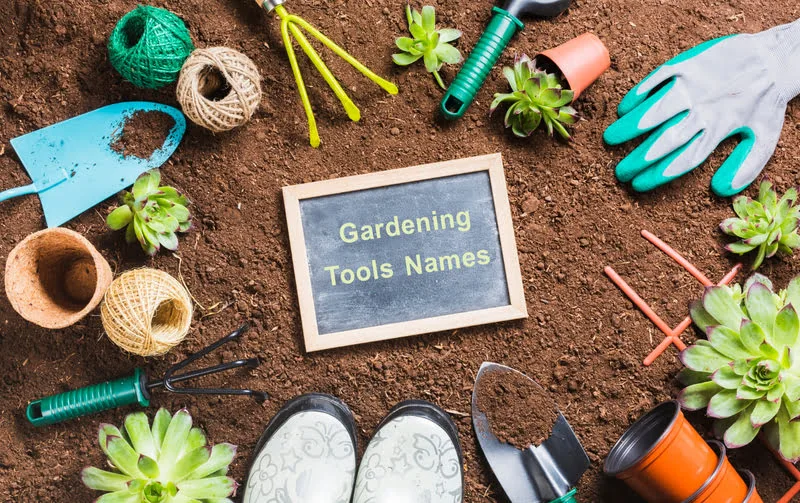
Garden tools vary in size and shape, each with specific purposes in gardening. Beginners must understand the tools needed for successful gardening. Learning the names of different gardening tools enhances efficiency, reduces mistakes, and improves gardening tasks. It’s important to know your gardening tools for various reasons.
Knowing how each tool works allows selecting the right one for better results, saving time and effort. Mastering garden tool names aids in effective communication with other gardeners, seeking advice, and learning new techniques. Familiarity with tools lowers accident risks by using them correctly.
Comprehensive A-Z List of Essential Garden Tools Names
From digging tools to cutting tools, planting tools to protective gear, we will explore a wide range of garden tools and their specific uses. By the end of this list, you will have a solid understanding of the different tools available to you and their respective names, empowering you with the knowledge to tackle various gardening tasks.
Digging Tools for Every Gardener

Digging tools are the backbone of every garden, playing a crucial role in preparation and maintenance. They help in soil aeration, planting, and various other gardening tasks. Here are some of the essential digging tools every gardener should have in their tool collection:
- Garden Spade: A versatile shovel-like tool used for digging, planting, and edging.
- Trench Shovel: Ideal for digging narrow and deep holes, such as for irrigation or fence posts.
- Post Hole Digger: A must-have for installing fences and digging small, precise holes.
- Irish Shovel: Known for its sharp blade and versatility in various gardening tasks.
- Digging Fork: Used for turning soil, breaking up clumps, and lifting soil effectively.
The Versatility of a Shovel
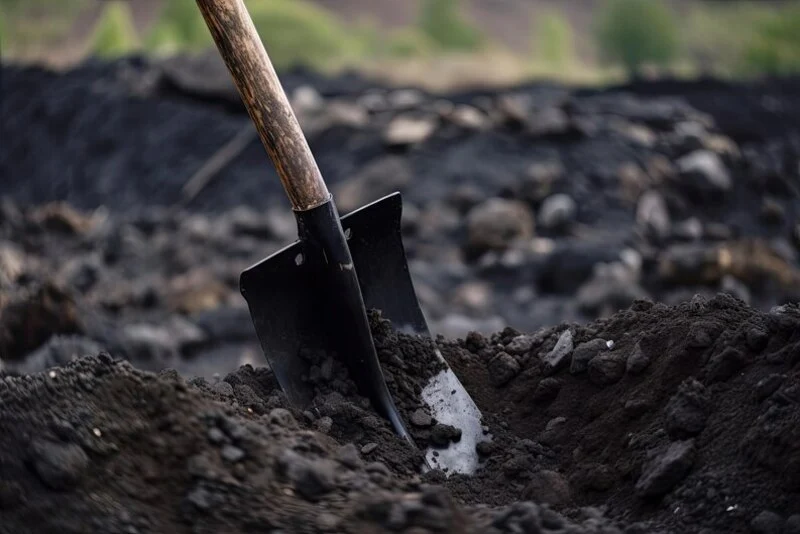
A shovel is a versatile gardening tool that serves a multitude of purposes in the garden. It is an indispensable tool for moving soil, mulch, and plants, and it can also be used for digging and trenching. The blade of a shovel can come in various shapes and sizes, each suited for specific gardening tasks, such as digging deep holes, creating trenches, or spreading soil evenly.
With its long handle, a shovel allows for better leverage, reducing strain on the body and making gardening tasks more comfortable. Whether you’re landscaping, constructing, or simply maintaining your garden, a shovel is an essential tool that should not be overlooked.
Differentiating Between a Spade and a Shovel
While spades and shovels are often used interchangeably, it’s important to note the differences between these two garden tools names. A garden spade typically has a flat, rectangular blade and a straight handle, while a shovel has a curved blade and a longer handle.
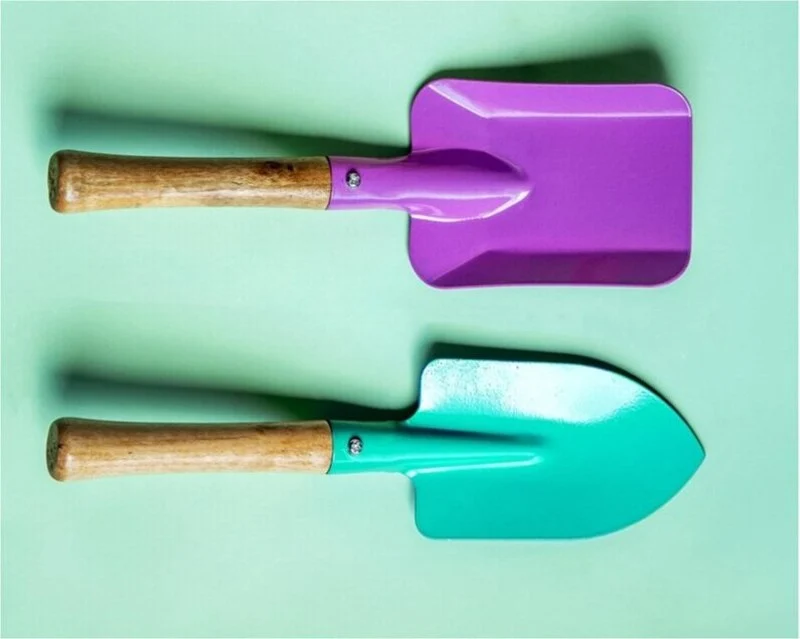
| Tools | Advantages |
| Spade | Best for well-defined edges, digging small holes, transplanting delicate plants, etc. |
| Shovel | Best for digging, lifting, moving soil, mulch, plants, and trenching, etc. |
Understanding the specific uses and names of garden spades and shovels will help you select the right tool for the job and ensure optimal performance in the Yard.
Garden Spade
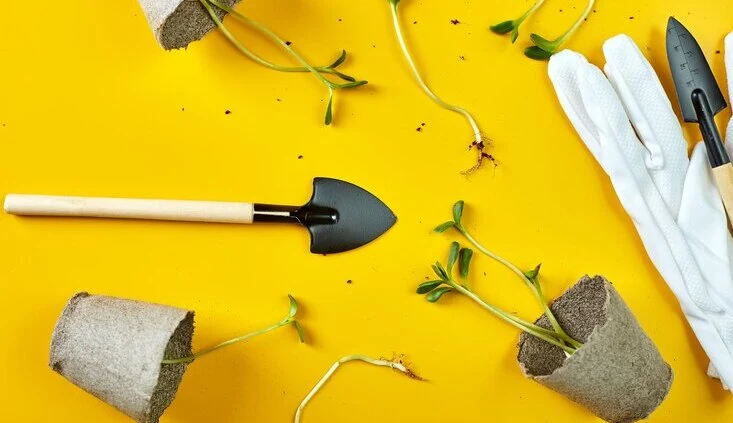
The garden spade, with its flat, rectangular blade and short handle, is a versatile digging tool that no gardener should be without. It is perfect for tasks such as digging, planting, and lifting soil. The design of a spade allows for precise digging and soil work, making it an essential tool for various gardening projects.
With a spade, you can create clean and well-defined edges, dig small holes with ease, and transplant delicate plants like a pro. The narrow blade of a garden spade also makes it ideal for edging and cutting through tough roots or sod. Invest in a high-quality garden spade, and you’ll have a tool that will serve you well for years to come.
Uses of a Trench Shovel
A trench shovel is an indispensable tool for gardeners who frequently need to dig narrow and deep holes, such as for irrigation systems or fence posts. The long, narrow blade of a trench shovel allows for precise digging, making it the perfect tool for creating narrow trenches or holes in the soil.
Whether you’re installing an underground sprinkler system or a new fence, a trench shovel will quickly become your go-to tool. Its ergonomic design and comfortable handle make it easy to handle, and its narrow blade allows for efficient digging in tight spaces. Having a trench shovel in your tool collection will greatly enhance your gardening capabilities.
Post Hole Digger
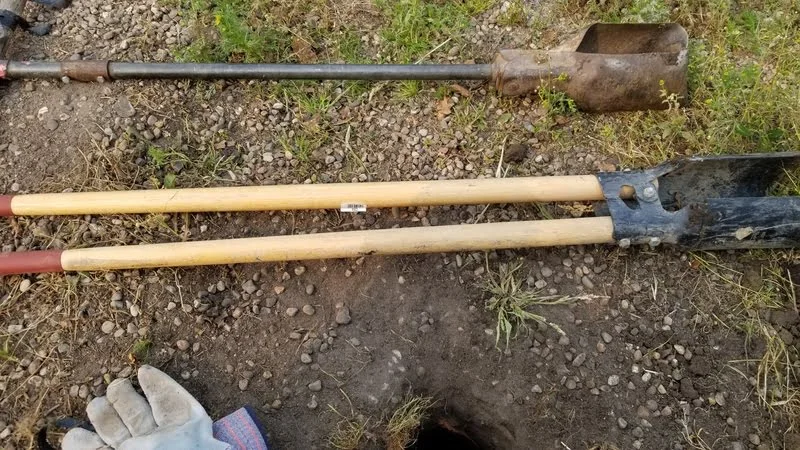
When it comes to installing fences or digging small, precise holes in the garden, a post-hole digger is a must-have tool. These tools are specifically designed to dig cylindrical holes in the soil, making them ideal for tasks that require a small, deep hole, such as installing fence posts or setting up a mailbox.
It comes in various styles and sizes, with some featuring long handles and others requiring manual effort. Consider the type and size of the holes you need to dig and choose a digger that suits your specific gardening needs. With this tool in hand, you’ll be able to tackle these tasks with ease and precision.
Efficiency of Digging Forks

When it comes to turning soil, breaking up clumps, and lifting soil effectively, a digging fork is an essential tool for every gardener. These tools, with their sturdy tines, are designed to penetrate the soil and loosen it, allowing for better aeration and drainage.
Digging forks are versatile gardening tools that can handle various soil types, and they are particularly useful in rocky or compacted soil. With their ergonomic handles and comfortable grips, digging forks allow for easy handling and reduced strain on the body.
Whether you’re preparing garden beds, cultivating the soil, or lifting root crops, a digging fork is a tool that will greatly increase your gardening efficiency.
Essential Pruning Tools
Master the art of cutting with essential pruning tools like stainless steel bypass pruners for cleaner cuts. Anvil pruners are perfect for thicker branches, while scissors can handle more delicate work on flower beds.
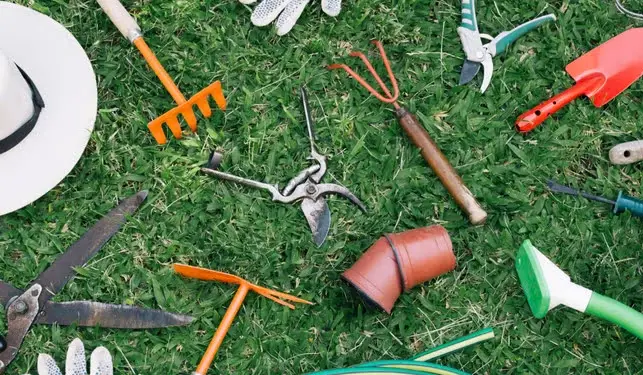
Understanding the top of the blade means precise cuts, especially for root crops. Choose the right tool for the job; a manure fork is ideal for rocky soil, and a scuffle hoe works well in veggie gardens.
Don’t forget the handy garden trowel—a versatile gardening tool for various gardening tasks.
Pruning with Shears

Pruning shears are essential tools for the delicate trimming and shaping of plants in the garden. Also known as secateurs, these cutting tools allow gardeners to make precise cuts on thin branches and stems without causing damage to the plants.
The bypass pruners and anvil pruners are the two main types of pruning shears, each serving different purposes.
By mastering the art of pruning with shears and understanding the different cutting techniques, gardeners can effectively maintain their plants, encourage healthy growth, and achieve aesthetically pleasing results.
The Role of Loppers

Loppers are a must-have tool for gardeners, especially when it comes to cutting thicker branches that pruning shears cannot handle. These long-handled cutting tools provide the leverage and cutting power needed to tackle larger, hard-to-reach branches in the garden.
Loppers come in various designs, such as bypass and anvil, each with its own advantages and uses. By using loppers correctly, gardeners can reduce strain on their arms and achieve cleaner, more precise cuts, resulting in healthier plants and a well-maintained garden.
Cutter Mattock and Axe:
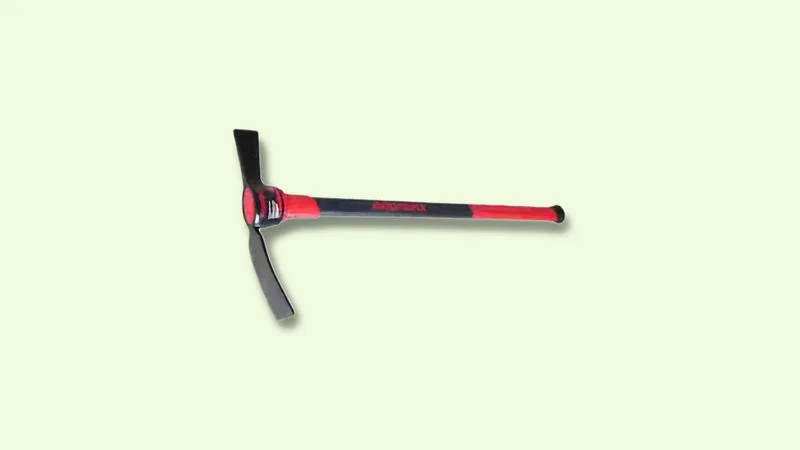
For heavy-duty cutting tasks, gardeners often turn to tools like the cutter mattock and axe. These tools are designed to handle the cutting of roots, small trees, and tough soil, making them indispensable in landscaping and other outdoor projects.
The blade of a cutter mattock allows for both cutting and digging, making it a versatile tool for various gardening tasks. Axes, on the other hand, are perfect for chopping wood and larger branches with precision.
When it comes to heavy-duty cutting in the garden, these tools provide the necessary power and efficiency to get the job done.
Planting Tools
Placing seeds into the ground is a crucial step in gardening success. Using tools like garden trowels for precise planting depths and veggie gardens, or border spades for more defined edges in flower beds, aids in achieving a well-designed garden layout.
For rocky soils, stirrup hoes are helpful for surface weeding, while manure forks assist in turning soil for root crops. Understanding how each tool works optimizes planting efficiency and results.
Garden Tool Hand Trowel
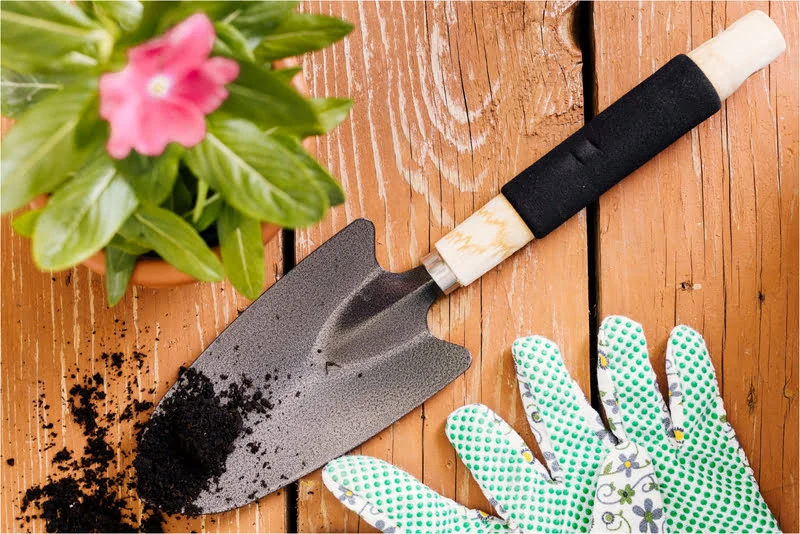
A hand trowel is a small, handheld tool that is highly efficient in various gardening tasks. It is a must-have tool for planting, transplanting, and digging small holes in the garden.
The compact size and sturdy construction of a hand trowel make it convenient for use in tight spaces, and the sharp blade enables precise digging and cutting through roots or tough soil.
With a hand trowel in hand, gardeners can easily handle various planting and digging tasks, ensuring the success of their gardening endeavors.
Garden Hoe with Handle:
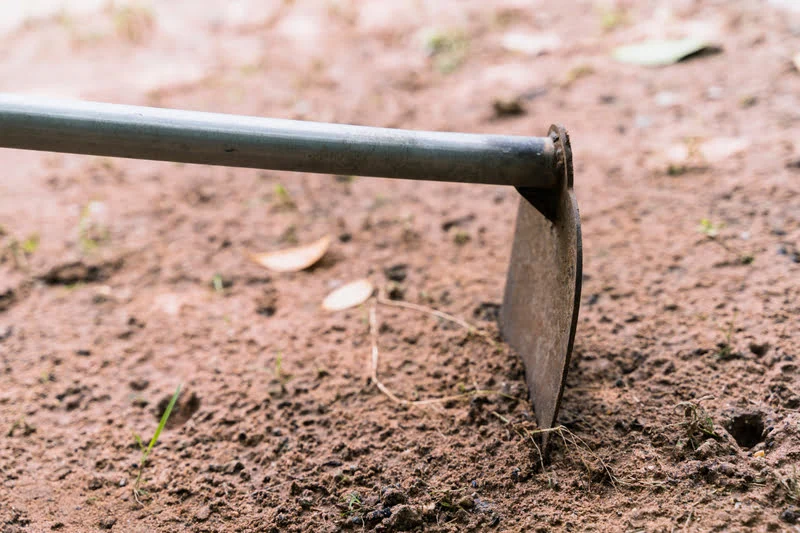
A garden hoe with a handle is a versatile tool that should be in every gardener’s arsenal. Its lightweight and durable construction makes it easy to maneuver, and the blade efficiently cultivates soil and removes weeds with minimal effort.
The fiberglass handle offers strength and shock absorption, making it comfortable to use even for extended periods. Garden hoes are available in various types, such as paddle, scuffle, and wire hoes, each with its own advantages and uses.
By investing in a garden hoe with a fiberglass handle, gardeners can ensure the cleanliness and health of their garden beds.
Tile for Specific Tasks
Specialty shovels, including tile shovels, are designed for specific gardening tasks, offering precision and efficiency. Tile shovels, with their narrow blades, are ideal for digging narrow trenches, making them essential in landscaping and construction projects.
These specialty shovels, with their specialized designs, enhance gardening precision and ensure optimal results.
Protective Gardening Gear for Safety and Comfort
Protective gear is crucial for garden safety and comfort. Choose stainless steel tools for durability. Consider using a scuffle hoe for weeding efficiency. Opt for a border spade in a veggie garden. When pruning, use bypass pruners for clean cuts.
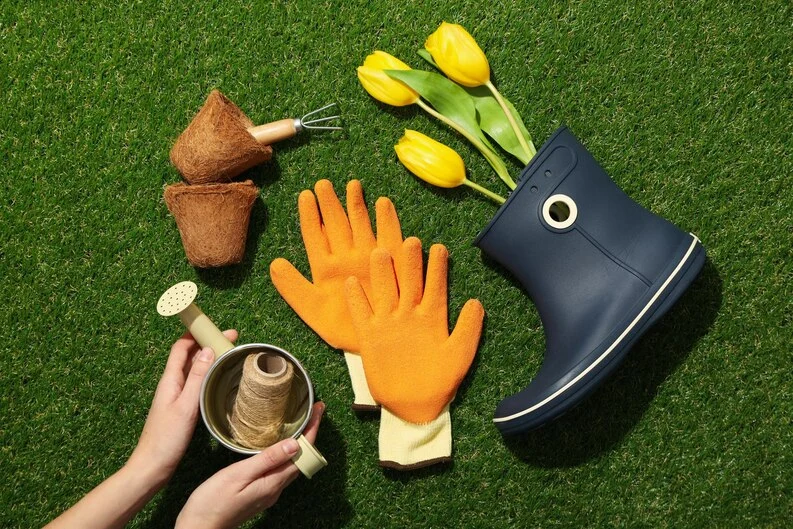
Anvil pruners are ideal for thick branches. Ensure safety with gloves when working near sharp objects. For comfort, a short-handled tool reduces strain. Incorporate these tips to enhance your gardening experience.
Gardening Gloves
Gardening gloves are essential protective gear that every gardener should have. They not only protect your hands from cuts, blisters, and moisture but also provide a comfortable grip and reduce strain on your hands and wrists. When selecting gardening gloves, look for gloves with good grip, durability, and breathable material for comfort.
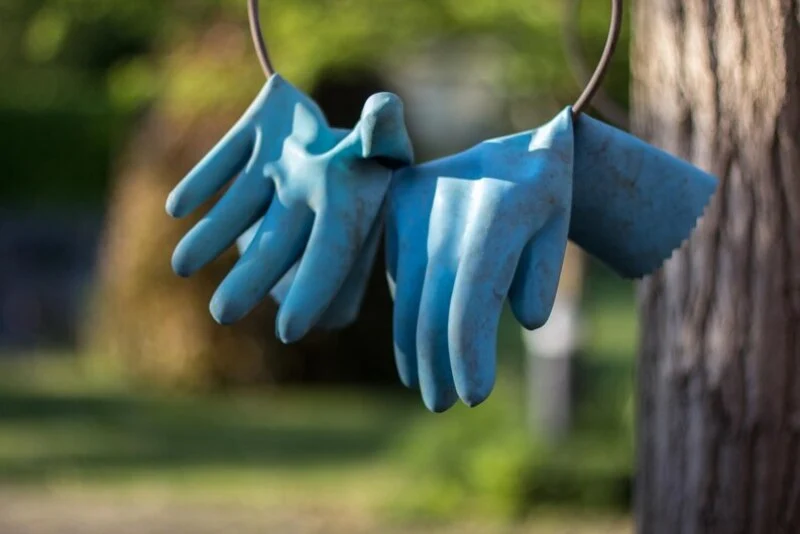
It’s important to choose gloves that fit well to avoid slippage and provide adequate dexterity for handling small objects. Additionally, opt for gloves that are easy to clean for convenience, ensuring their longevity and effectiveness in the garden.
Garden Fork is Essential for Gardener’s Safety?
Garden fork: It helps in aerating and turning soil, lifting and moving heavy materials, and breaking up compacted soil effectively. The sturdy tines of a fork penetrate the soil with ease, enabling gardeners to work efficiently and reduce strain on the body.
A high-quality garden fork is a versatile tool that can handle different jobs in the yard, ensuring the safety and comfort of the gardener during various gardening tasks.
Maintenance Tools in Gardening with Names
To maintain your garden’s pristine condition, utilizing the right maintenance tools is crucial. Rakes play an indispensable role in keeping your garden well-groomed, while a grub hoe and weeder tool aid in efficient weed removal.
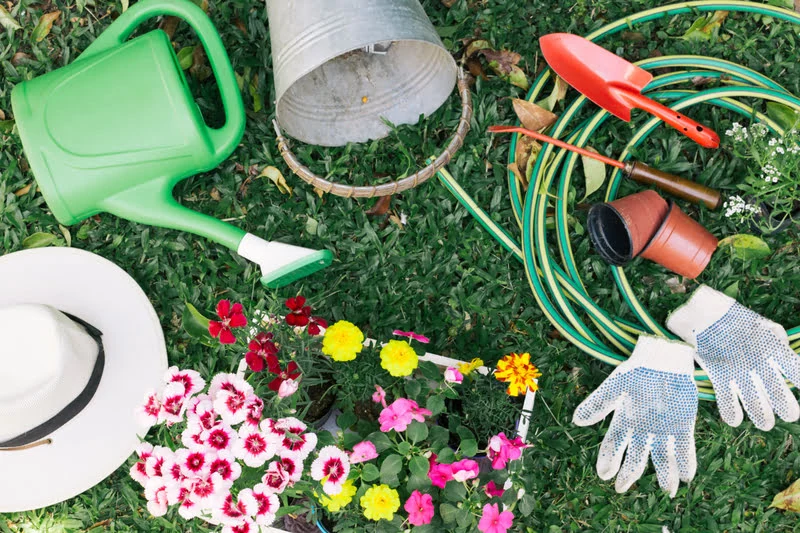
Additionally, essential watering tools like a water hose, water can, and water. Ensure your plants receive adequate hydration for optimal growth and health. Owning and using these maintenance tools regularly will help you keep your yard in top shape effortlessly.
Role of Rakes
Rakes play an indispensable role in maintenance, helping to remove leaves, debris, and thatch from lawns and garden beds. Garden rakes, leaf rakes, and thatch rakes are specifically designed for different tasks and surface types, ensuring optimal results in yard maintenance.
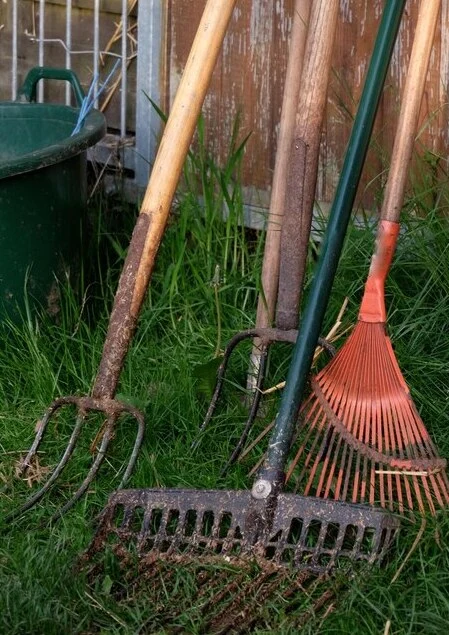
leaf rake: is a vital gardening tool designed for collecting leaves and grass clippings. The sturdy steel tines provide a strong grip on debris, making it easy to move around your grounds.
Garden rakes: They are perfect for leveling soil, spreading mulch, and clearing debris. Their long handles make it easy to reach into tight spaces and their sturdy tines make quick work of any task.
Thatch rakes: Helps to remove built-up thatch, allowing for better air circulation and nutrient absorption in the soil. Thatch rakes come in a variety of styles and sizes, but they all serve the same purpose of keeping your yard in top condition.
Regular use of a rake improves the health and appearance of the garden by reducing the accumulation of debris and allowing for better light and air circulation. Proper maintenance and storage of rakes ensure their longevity and effectiveness in garden maintenance.
Grub Hoe and Weeder Tool
Grub hoes and weeder tools are essential for gardeners, particularly when it comes to removing tough weeds and roots from the garden.
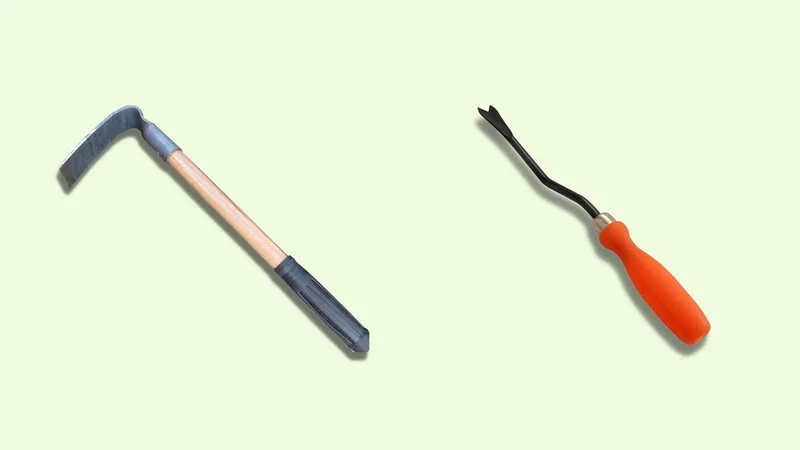
Grub hoe: this is a versatile gardening tool with an elongated handle and sharp blade, offering improved leverage and reducing back strain. It’s effective for tough weeds with deep roots, cutting through soil and roots efficiently.
The long handle provides better reach and control, allowing comfortable work without excessive bending. Essential for maintaining a tidy, weed-free outdoor space with minimal effort.
Weeder tool: on the other hand, is designed to prevent the spread of weeds and keep the garden looking tidy. These tools, with their sharp blades and ergonomic designs, save gardeners time and effort by simplifying the task of weeding.
Proper maintenance and care of grub hoes and weeder tools ensure their efficiency and longevity in the garden.
Essential Watering Tools:
Watering tools of gardening with names are essential for maintaining the health and vitality of your garden. A garden hose, water can, and water wand are the basic tools for efficiently watering plants.

Water can: is ideal for targeted watering of smaller plants or hard-to-reach areas.
Water hose: allowing for easy and efficient watering of plants. With an adjustable nozzle, you can control the water flow and reach different areas of your garden with ease. It is important to choose a hose diameter that suits your needs, whether you require a lower or higher water flow rate.
Water wand: provides the flexibility to easily water hanging baskets or taller plants. By having these essential watering tools in your gardening arsenal, you can ensure that your plants receive the proper hydration they need to thrive.
I think you have learned basic garden tools names now to implement them check this post Square Foot Gardening Planner: Top Guide for Beginners.
Garden Items Names: Beyond the Basics
Exploring beyond the fundamental tools, stainless steel options offer durability for rocky soil. Bypass pruners provide cleaner cuts for thick branches in flower beds. Anvil pruners work well on root crops with a long-lasting impact.
Scuffle hoes are ideal for different jobs in veggie gardens. Featuring a short handle and rectangular blade, an action hoe efficiently works on various surfaces. Including an array of versatile gardening tools like manure forks and hula hoes enhances your gardening experience.
Basic Tools Every Gardener Should Own
Every gardener, whether a beginner or an expert, should have a set of basic tools in their arsenal. These items are essential for various gardening tasks, allowing gardeners to maintain their garden beds and achieve optimal results. Here are some of the basic tools that every gardener should own:
- Hand Trowel: Used for digging, transplanting, and digging small holes.
- Pruning Shears: Essential for cutting back plants, shaping bushes, and deadheading.
- Garden Fork: Perfect for turning soil, mixing in amendments, and aerating.
- Watering Can: Ideal for gentle and precise watering of plants.
- Hoe: Helps with weeding, breaking up soil, and cultivating.
- Rake: Useful in collecting leaves, smoothing soil, and leveling beds.
Advanced Tools for Specialty Gardening Tasks
For gardeners with specific gardening tasks or interests, advanced tools are available to meet their needs. These tools are designed to handle specialized gardening tasks, making them indispensable for specialty gardening projects.
Some of the advanced tools for specialty gardening tasks include bulb planters, pruning saws, and soaker hoses, among others. By investing in these tools, gardeners can achieve better results and make their gardening tasks more efficient and enjoyable.
Whether you’re grafting, topiary shaping, or tending to a bonsai, having the right advanced tools in your possession will set you up for success in your specialty gardening endeavors.
Conclusion of Garden Tool Names List
Having the right garden tools by name is crucial for successful gardening. Quality tools make gardening easier and last longer. The joy of gardening is enhanced with efficient maintenance using proper tools. Cleaning and storing tools correctly is vital for their durability. Make a wishlist to improve your green in the future.
Essential Tools for Successful Gardening: Having these tools is essential for success in gardening. This list covers a wide range of tools from digging to cutting, planting to maintenance. With the correct tools, you can easily care for your garden, handle tasks effectively, and get great results.
Remember to clean and store your tools well for them to last through all seasons of gardening. Don’t hesitate to reach out with any questions or share your own gardening tool insights in the comments below. Happy gardening!
Frequently Asked Questions
What’s the best hand-weeding tool?
Some popular hand-weeding tool brands include Fiskars, Corona, and Wilcox, known for their quality and durability.
When selecting a hand-weeding tool, look for a comfortable grip, sturdy construction, and a sharp blade for effective weeding in the garden.
With the right-hand weeding tool in hand, you can keep your garden free of weeds and maintain its overall health and appearance.
What is a weeder tool?
A weeder tool is a garden tool specifically designed to remove unwanted plants, weeds, and roots from the soil. Weeder tools come in various types, including hand weeders, stand-up weeders, and weeding knives, each with its own advantages and uses.
What is a sharpshooter shovel?
A sharpshooter shovel is a specialized type of shovel with a narrow blade, making it ideal for digging narrow, deep holes in the garden.
It is specifically designed for tasks that require precision, such as planting trees, shrubs, or deep-rooted plants. The narrow blade of a sharpshooter shovel allows for easy penetration into the soil, making digging holes a breeze.
What is a garden spade best for?
A garden spade, with its flat, rectangular blade and short handle, is best suited for digging, planting, and edging in the garden. Its versatile design and sharp blade make it an indispensable tool for various gardening tasks.
A garden spade is perfect for digging small holes, creating clean and well-defined edges, and transplanting delicate plants with precision.
What are the basic tools for gardening?
Here are some of the basic tools that every gardener should have:
1. Hand Trowel
2. Pruning Shears
3. Garden Fork
4. Watering Can
5. Hoe
6. Rake
Having these basic tools in your gardening arsenal will ensure that you’re ready for a wide range of gardening tasks, allowing you to maintain a healthy and beautiful garden.
How do you keep a pick mattock?
To keep a pick mattock in good condition, it’s important to clean and maintain the tool properly. Here are a few tips:
1. After use, clean the pick mattock with water and a brush to remove dirt and debris.
2. Dry the tool thoroughly to prevent rusting.
3. Store the pick mattock in a dry place, away from moisture, to further prevent rusting.
4. Periodically inspect the handle for any signs of wear or damage and replace it if necessary.
5. Apply a light coat of oil to the metal parts of the pick mattock to prevent rust and maintain smooth operation.
6. Following these maintenance tips will ensure that your pick mattock remains in top shape and ready for use in your gardening and landscaping projects.
How big is a shovel?
A shovel’s size varies, with a standard blade typically 8-10 inches wide and a handle around 40-48 inches long. Types include square point, round point, and garden spade. Choose based on your gardening needs, considering size and weight.